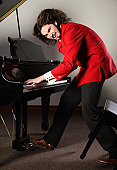
How to Comp Chords For Jazz Piano
The accompanist, usually a pianist, guitarist, organ, or other instruments, have this complicated job of supporting the soloist while he or she does the more complicated work of improvising the melody. In this article I will try to explain the commonly-used practices of comping chords for jazz piano music Other things to think about are the number of comping instruments or accompanists in a jazz band. While one type of instrument could use one type of comping, the other instrument could use another. Sometimes, you could have situations where the instruments clash with one another. For instance, the piano could use a dominant seventh with a natural 13th, where the guitarist would use a sharpened 13th, causing a clash in harmony. Or the soloist could have an idea of what he wants to achieve with the melody, but the accompanist could have another plan. Comping chords are often defined as spicing UP chords to support the improvised jazz melody. On the piano you would for instance start on G, then playing B, F, A and E above it. However, it is difficult to play the chords in such a wide spectrum. So what the usual jazz pianist does, is just to fit in the 13th and 9th notes in between or to leave out some. This would look as follows: G, B, E, F, and A. But, unfortunately, it isn’t as easy as or simplistic as this in most cases.
For example: in the key of C Major, the dominant seventh of C Major, on G, they would use the following notes: A flat, A sharp, E flat, C sharp, and others as well. This, of course could form endless possibilities of establishing various types of chord structures and differently sounding harmonies. It all depends on the feel or mood of the soloist. If the melody is more dense and complex, one would use more 9ths and 13ths in one’s comping. Needless to say, there must be a constant communication between the soloist and comper. For one, the soloist may use different types of rhythms in his melody or improvisation. The accompanist must keep the whole band together, ensuring that everyone stays at the same energy level as the soloist. Comping doesn’t only include chords, but also includes supportive and backing melodies for the tune of the soloist. Therefore, the accompanist doing the comping must listen with a fine ear to the soloist, to hear whether the melody and improvisation might change. In which case, he must use another type of rhythm or melody to lead the other instruments to follow the soloist. In drum solos, the piano comper uses what they call hits to rhythmically support the drums in a smart way, thereby, forming two types of rhythms, complementing one another. For good exercises to learn jazz piano comping, listen to well-known jazz pianist compers like Wynton Kelly, Herbie Hancock, Oscar Peterson, and Count Basie to hear the different types of comping. Some comp sparsely, while others like to go wild. Try the different types of chords with the added notes. Put on a recording of your favorite jazz song, and try your comping skills together with the famous!
| ||||
|
Although every attempt has been made to make information as accurate as possible, we are not responsible for any errors that may appear.
 Comping, or also known as filling in the harmony, is a commonly-heard and
important integration of jazz music. It requires skill and knowledge of advanced chord structures and added
voicings to it.
Comping, or also known as filling in the harmony, is a commonly-heard and
important integration of jazz music. It requires skill and knowledge of advanced chord structures and added
voicings to it.
 Jazz musicians also like to alter these notes. What I mean is that they often
sharpen or flatten certain notes. Usually the fifth, ninth, and thirteenths.
Jazz musicians also like to alter these notes. What I mean is that they often
sharpen or flatten certain notes. Usually the fifth, ninth, and thirteenths.


